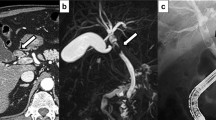Abstract
We report herein the case of a 63-year-old man in whom delayed rupture of a pseudoaneurysm occurred 120 days following pancreatoduodenectomy. Color Doppler examination indicated a pseudoaneurysm originating from the ligated gastroduodenal artery. Transcatheter arterial embolization was done at the common hepatic artery, proximal and distal to the pseudoaneurysm, with microcoils. The patient had a minor elevation of liver enzymes, which subsequently returned to normal. Due to the absence of any postoperative complications such as pancreatic anastomotic leakage, we assumed that the pseudoaneurysm formation had been caused by a weakness in the arterial wall according to skeletonization resulting from lymphadenectomy and intraoperative radiation therapy. To our knowledge, this case represents the longest interval between pancreatoduodenectomy and rupture of a pseudoaneurysm ever to be reported in the literature.
Similar content being viewed by others
Author information
Authors and Affiliations
Additional information
Received: November 6, 2000 / Accepted: May 15, 2001
Rights and permissions
About this article
Cite this article
Sugimoto, H., Kaneko, T., Ishiguchi, T. et al. Delayed Rupture of a Pseudoaneurysm Following Pancreatoduodenectomy: Report of a Case. Surg Today 31, 932–935 (2001). https://doi.org/10.1007/s005950170039
Issue Date:
DOI: https://doi.org/10.1007/s005950170039




